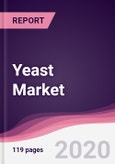Yeasts are eukaryotic, single-celled microorganisms that belong to the fungus kingdom. Their ancestors are multicellular and they reproduce asexually by mitosis or budding. Predominantly, yeasts have applications in food, alcoholic & non-alcoholic beverages, pharmaceutical, and other indispensable products because of which yeast market revenue is consistently on the rise.
Yeast Market Trends – An Evaluation of Growth Driving Factors
Alcoholic Beverages Market: A Boon to the Yeast Market –
Beer, wine, and liquor are alcohol derivatives produced by the fermentation of yeast. The beer consumption is ubiquitous in the world with a whopping 186.72 million kiloliters of consumption in 2020, according to the Kirin Beer University. Even though it is a 0.2% decline compared to the previous year, beer-producing industry is still a humongous yeast marketplace.
Now, according to the Alcohol and Tobacco Tax and Trade Bureau, U.S. Department of Treasury, the annual wine production was 64.83 million Gallons as of May 2020, and the figure is only going to observe increment in 2020. This opens up the yeast market in the U.S.
According to The Organization for Economic Co-operation and Development (OECD), the household disposable income in most of the parts of Europe is going uphill with the annual growth rate between 1% and 5%. The expenditure of disposable income also attributes to alcohol consumption. Additionally, Europian countries have a culture of drinking wine with dinner. This makes Europe a huge target region for the yeast market revenue avenue, and evidentially, the region bears the yeast market share of 30-33% according to the business analyst.
This increase in the disposable income and inception of weekend culture in most parts of the world is another reason because of which the yeast market is thriving.
Bioethanol: A Growing Demand Stroking Yeast Market –
Compared to petrol, bioethanol is more eco-friendly as it is manufactured from the agricultural, household, and other wastes, and yeast fermentation is part of the manufacturing process. Bioethanol, when mixed with petrol leads to complete combustion and reduces the pollutant emissions, thereby making the air healthy for breathing.
Now, according to WHO, 4.2 million people die as a result of air pollution, some of which is because of the vehicular air pollution. Developed countries like the U.S. and the ones in Europe have very stringent environmental regulations. This is making the application of bioethanol imperative. Many countries like the U.S. and Brazil are also using it as an alternative to petrol, which is opening up the yeast market in those regions. The regulations pertaining to vehicular pollution will be applicable to the developing countries in the near future which will further flourish the yeast market.
Pharmaceutical Proteins – A Yeast Fermentation Product
Protein-based drugs are the fastest growing drugs in the pharmaceutical industry as they cure people suffering from infectious, inflammatory, and cardiovascular diseases. Yeast fermentation is a part of the manufacturing process of these drugs. Now, a multitude of people suffers from these diseases annually. It opens up the market for pharmaceutical proteins which further strokes the yeast market.
Organic Yeast – A Market Trend Increasing Yeast Market Revenue
Conventional yeast production utilizes harsh chemicals like sodium hydroxide, ammonia, and ammonium salts. It also uses synthetic vitamins that lead to vitamin poisoning and other side effects. Now, to ameliorate this, a lot of consumers are opting for organic yeast which is more healthy and superior than the inorganic one. Organic yeast is now used in a lot of bakery products which is already a huge marketplace for yeast.
Even though organic yeast is expensive, the consumers in developed countries like the U.S., the UK, and other European countries are opting for it. This is not only catapulting the yeast market growth in those regions but also the urban regions of developing countries where people can afford organic yeast. It also happens to be one of the reasons for the yeast market share in food application to be the highest 7%-8% according to the publisher’s analyst.
Yeast Market – Leading Players Leveraging the Growing Demand of Yeast Products
Associated British Foods Plc is a market leader operating in the yeast and bakery products domain. Their yeast and bakery ingredients operated by AB Mauri witnessed a revenue of $1,915 million in 2020, which was more than the revenue in 2016, reported at $1695 million in 2016. This growth in revenue majorly attributed to the growing demand for bakery products.
Another player in the yeast market is Angel Yeast which posted the net profit of $847 million in 2020, an increase of 58.33% year on year.
Some other companies operating in the yeast market are Pakmaya, Bio Agro, CHR Hansen Group, Dakota Yeast LLC, Lallemand Inc, Leiber Group, Lesaffre Group, and Levapan Group.
The alcohol consumption, especially beer and wine is going to see a growth attributing to various factors like disposable income and weekend culture. Furthermore, with environmental regulations regarding air pollution coming into the picture, the demand for bioethanol in a lot of developed countries will increase. The ever-growing sales of baking products and the rising need for organic yeast and pharmaceutical proteins will propel the yeast market growth in the forecast period of 2020-2025.
Table of Contents
Methodology

LOADING...








